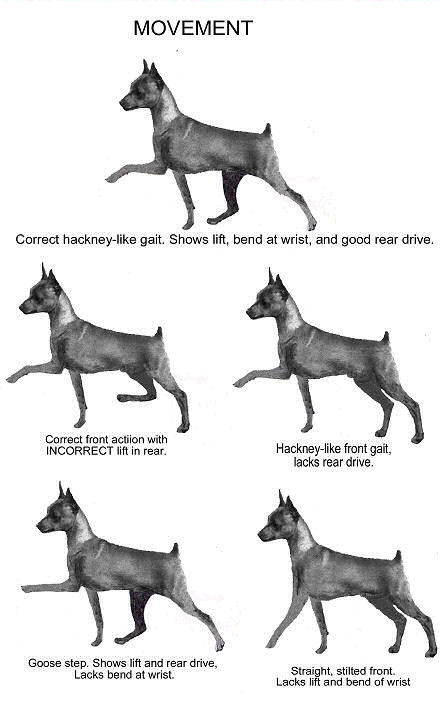AKC Standard:
Gait – The forelegs and hind legs move parallel, with feet turning neither in nor out. The hackney-like action is a high-stepping, reaching, free and easy gait in which the front leg moves straight forward and in front of the body and the foot bends at the wrist. The dog drives smoothly and strongly from the rear. The head and tail are carried high.

Discussion:
The Min Pin should be sound coming and going, with forelegs and hindlegs moving parallel. Coming toward you, the legs should be lifted straight and true. The dog should not single track.
Min Pin movement is often misunderstood. The correct hackney-LIKE gait is described fully in the standard. To paraphrase, the dog lifts his front feet up and out with a bend at the wrist while driving from behind. The dog should move forward quickly and smoothly with a minimum amount of effort. Judges must realize that the standard does NOT call for “true” hackney action, which is considered a mincing, inefficient gait with no rear drive.
The front movement must show a definite bend or break at the wrist/pastern joint, while also exhibiting extension and reach, with strong rear drive. The topline should remain solid with the head and tail carried high.
While it is important for the front wrist bend to be present, it does NOT have to be high or extreme. In fact, exaggerated front action is often accompanied by a lack of soundness. It should be remembered that the hackney-like action refers to FRONT movement only. The smooth and strong rear drive called for in the standard does not permit inefficient “lift” of rear legs.
The high stepping front action occurs as a result of the moderately angled front and slightly more angulated rear of a properly built Min Pin. The pasterns must be flexible enough to permit the wrist to bend.
CORRECT HACKNEY-LIKE ACTION
These are examples of proper movement. Notice that these dogs show varying degrees of lift and bend of wrist. However, all have the required rear drive, carry tail and head up, and hold a level or slightly sloping topline

It is important to observe the Miniature Pinscher in side gait as well as coming and going. Many movement faults may be observed including loose shoulders, out at the elbows, “mix master” (rotary action) fronts, crossing (front or rear), moving too close or too wide, no rear drive, no bend of wrist, or no lift.
Some handlers may try to disguise faults, or give the appearance of more lift by tightly stringing up their dogs.
Flashy front action is wonderful to see, but the judge must consider the WHOLE dog; it is also important for the Min Pin to be sound and have proper breed type.

